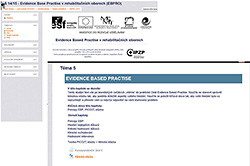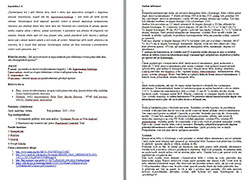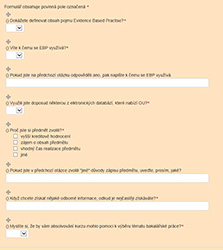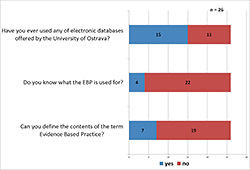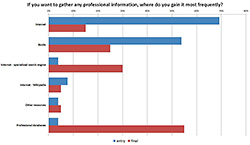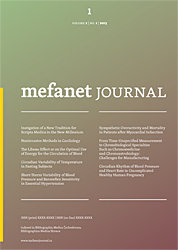
MEFANET Journal 2017; 5(2): 47-53
ORIGINAL ARTICLE
Evidence-based practice in the field of rehabilitation
Jarmila Kristiníková1*, Hana Sochorová2, Markéta Poštulková1
1 Department of Rehabilitation, University of Ostrava, Ostrava, Czech Republic
2 Department of Biomedical Sciences, University of Ostrava, Ostrava, Czech Republic
* Corresponding author: jarmila.kristinikova@osu.cz
Abstract
Article history:
Received 3 January 2017
Revised 16 February 2017
Accepted 11 April 2017
Available online 26 April 2017
Peer review:
Radana Poděbradská, Jiří Kratochvíl
Download PDF
Background: At universities, the EBP course occurs within the master's degree or doctorate studies. To be able to make the right decision based on finding relevant evidence is one of basic skills of a university educated graduate of medical fields.
Objectives: The aim of this study was to determine the degree of awareness of physiotherapy and occupational therapy students about the principles of Evidence Based Practice (EBP), to inquire into their ability to use electronic information resources for searching strategies, and apply the results in practice.
Methods: Students in this study were tested by means of a questionnaire survey at the beginning and at the end of the training course Evidence Based Practice for rehabilitation disciplines.
Results: The results show that after completing EBP course, students were able to define the term, to search in electronic information resources, and to apply the results to practical tasks more efficiently.
Conclusion: In this pilot study, significant differences in the results have been found between the answers to the questions in the input and output surveys. The results confirm our hypothesis about the benefits of the EBP course, even in undergraduate studies. The students can apply acquired knowledge and skills in subsequent studies.
Keywords
Evidence-based practice; information resources; Internet; education; rehabilitation
Introduction
Evidence-based practice (EBP) is an interdisciplinary approach which appeared for the very first time in medicine as Evidence-Based Medicine and subsequently was transferred to other fields, e.g. psychology, nursing, education etc. First EBM principles occurred in clinical practice in the beginning of the 20th century in surgery. Later on more extensive studies were published, e.g. in the treatment of tuberculosis. However, the first one who applied statistic evaluation of therapeutic results, the French physician Charles-Alexandre Louis, proved blood-letting ineffective. The term EBM itself was probably used for the first time in the 1990s by MacMasters University employees as "systemic approach to the analysis of published research papers as the basis for clinical decision-making" [1].
Since 1995, the concept of evidence based practice has developed also in other health care branches, e.g. in nursing (Evidence Based Nursing), midwifery (Evidence Based Midwifery), in physiotherapy (Evidence Based Physiotherapy), occupational therapy (Evidence Based Occupational Therapy), in public health (Evidence Based Public Health), but also outside health service, e.g. in librarianship (Evidence Based Librarianship) and in law (Evidence Based Law). The World Confederation for Physical Therapy (European region) defined EBP as "a commitment to use the best available evidence to inform decision-making about the care of individuals that involves integrating physiotherapist practitioners and individual professional judgement with evidence gained through systematic research" [2].
The principle of EBP application is making decisions about further procedure for patients based on research, where efficiency of procedures is compared and the best possible solution is searched out for the given case. EBP makes problem solution in clinical practice possible and ensures an effective approach to clinical decision making based on searching for the best and latest evidence, clinical experience, patients’ evaluation and value preference connected with health care [3].
Evidence based practice is one of those approaches that enable future health care providers to manage an explosion of new technologies, findings, literature, and it will consequently lead to improvement of patient’s results. Courses aimed at EBP in study programmes in rehabilitation field can be found at universities of medicine or health studies, either separately, or the EBP principles are implemented in other education courses, most frequently in research methodology. EBP has provided a great development especially in nursing [4,5].
In the field of rehabilitation, Evidence Based Practice (EBP) is a very frequently discussed term in practice. There are no uniform estimations of using EBP principles and both supporters and eager opponents of this approach can be found. Obviously, the clinical practice itself is not the most important argument to decide on the application of a specific therapeutic procedure for physical treatment. Economic, personal and technical aspects must be considered, too. Integrating EBP into the education is the most frequently used in nursing. Also, most studies dealing with the evaluation of the benefits of EBP by nurses. For students of physiotherapy, EBP principles are not applied in teaching standards. Physiotherapy students mostly learn basics of Evidence Based Practice during their Master study. This is a major reason why they are hardly able to apply the EBP fundamentals in practical therapy after graduation.
A piece of work from 2009 examined the awareness of EBP at Czech occupational therapy facilities by means of a question form [6]. Very low awareness about EBP among occupational therapists was concluded, although it was included in undergraduate university education in nursing simultaneously [6].
Evidence-based practice in study plans of rehabilitation branches at the Faculty of Medicine, University of Ostrava
As mentioned above, nursing has the longest tradition of involving EBP in curricula where also the methods of project teaching are being used. Project education is based on theory and practice interconnection and improves the student’s creativity. Using a project in teaching of the course Evidence based practice shows to be an effective way of how to acquire knowledge and use it to solve problems relevant to clinical practice [7].
Within a project focused on teaching innovation in paramedical study branches, a new course Evidence Based Practice in Rehabilitation Branches was created which was integrated into study plans of the branches physiotherapy and occupational therapy. To support the teaching, a resource text was elaborated and e-learning course within LMS Moodle was created [8–10].
Pilot courses
The course was involved in teaching for the very first time in the study programme Specialization in health service in the branches physiotherapy and occupational therapy in summer semester of the academic year 2011/2012. The course was offered to students of physiotherapy and occupational therapy within one common course because of a very useful cooperation of these professions in comprehensive patient’s therapy in practice. There was also the intention to develop common topics for problem solution within multidisciplinary approach.
Figure 1. Setting of the e-learning course EBP in rehabilitation fields. In topic 5, students learn how to formulate the PICOT question in the right way so that the question expresses important aspects of search
Figure 2. Illustration of solving a case study of a patient with urinary incontinence. The student had to answer the question how to motivate the patient to exercise the pelvic floor muscles regularly in order to avoid surgery
Figure 3. Initial questionnaire in the beginning of teaching
Figure 4. Illustration of outputs of the initial questionnaire
Figure 5. Comparison of used information resources in the beginning and after completion of the course
The teaching was led in a combined form with e-learning support and emphasis on the work itself. Students got a theoretical part that explained EBP history and principals, methods of how to formulate the clinical question (PICOT: P – stands for patient population, I – represent issue of concern or intervention, C – stands of comparison intervention, O – signifies outcome, T – stands for time duration) and how to evaluate the results found. The EBP application in the classes referred to searching in electronic information sources available at the university. In collaboration with a university librarian, the most suitable electronic databases for rehabilitation branches were searched out. Students were acquainted with principles of searching according to key words in Czech as well as in English languages and they practised searching for solution of real tasks in electronic databases. In the e-learning course, students elaborated five assignments. The tasks concerned both to work with electronic databases and search strategy but also to form clinical questions. As a course conclusion, each student compiled a case study related to a particular diagnosis in which he/she chose a treatment strategy related to the sought arguments [10].
Within practical skills, a portion of searching in electronic databases, available at the University of Ostrava, was involved in the course. A university librarian, who participates in teaching, seeks out the up-to-date information databases especially suitable for physiotherapists and occupational therapists so that the students can search for and work with professionally directed pieces of information.
Implementation in standard teaching
In academic year 2014/2015, the course was implemented in the bachelor study of physiotherapy as obligatory-optional or optional course in the summer semester of the second year of study. From this time onwards, the course has been taught five times, and 68 students have completed the course.
The teaching is implemented, as mentioned above, with an e-learning support in LMS Moodle. The illustration of the setting is shown in Figure 1.
Within the course, students compiled particular case studies in the form of correspondent tasks. Students picked up from 10 offered case studies – case studies concerning patient with autism, with apallic syndrome, cerebral palsy, urinary incontinence, multiple sclerosis, the issue of doing sports during pregnancy, falls in senior facilities, well-timed diagnosis of defective posture, amputations and signs of dementia are being solved. Figure 2 presents selected issues solved by EBP methods.
Methods
In the pilot course in academic year 2011/2012, an interview took place in the first lesson where the students explained why they had enrolled the EBP course, and what their expectations were. Most students did not know what the term Evidence Based Practice means, they had no expectations and they enrolled the course due to its attractive credit rating. At the course end, an interview with students proceeded again. It aimed to evaluate the course, specify particular benefits for individual students and analyse deficiencies. It was observed that students missed basic orientation in research frequently. In searching in electronic information resources, students were successful under direct teacher’s guidance only.
In academic years 2013/2014 and 2014/2015 students were offered to take part in initial and final course evaluation. The survey was conducted via a questionnaire. The questionnaire included both closed and open questions aimed to find out how students understand the concept of Evidence Based Practice, whether they can explain it. We also wanted to find out if they know the electronic information resources and focus on the search strategies (Figure 3). Students' answers were evaluated in percentages. The questionnaire was applied twice as entrance and exit survey and the results were compared.
Results
Twenty-six students in two academic years participated in the study, all have filled in the input survey while the final one was completed by 20 students.
Only 7 students out of the total 26 involved in the initial survey knew the term EBP in advance, the other heard it for the very first time. Out of 7 students, who had heard the term before, only three answered that they knew what the results acquired by means of EBP could be used for and just one student out of these three characterized EBP correctly. There was a different situation after the end of the course. 20 students took part in the final survey and all of them answered positively the question whether they are able to define meaning of the term EBP. In addition, each answer contained proper example of EBP result practical application.
The orientation in electronic university databases was another part of teaching. In the initial survey, 15 students out of 26 stated they had already used any database. This low number shows that students were not used to search for needed pieces of information by means of EIS very much. Most of them (17 students) mentioned the Internet without any detailed specification as the most common source of information. Then, during oral questioning, they mentioned only general search engines as Google or Seznam.cz and the like. It took them too much time to find the needed information due to the lack of any searching strategy, and they did not know about existing special databases for physical therapy or occupational therapy, either. Professional books or journals were given as the most frequent source of information. In the final survey, all 20 respondents replied they started using university EIS to a larger extent to search information for study. EBSCO, MEDLINE and Google Scholar (100%) were found most beneficial. Although the students got familiar with university EIS, searching strategy, defining the key words and their English equivalents seemed to be their permanent problems. These troubles were especially obvious when they should have worked without tutor's assistance.
Discussion
Although this was just a pilot survey with a small number of participants, the results are interesting and inspiring. The introduction of EBP in physiotherapy and occupational therapy curricula at the undergraduate level is not quite standard, this is rather the domain of nursing. The research of the effectiveness of acquired knowledge and skills after the completion of such a course of study can be found mostly in nursing, too. Our results related to the understanding and definition of EBP and its contents correspond to the results of Martinez et al. [12], performed in university nursing students. Increased skills in using EBP tools after 15 weeks of education were discovered, which is almost identical to our time allocation of 14 weeks.
Nevertheless, it should be noted that at least some students of the bachelor study fields physiotherapy and occupational therapy knew the term but they cannot explain it correctly. The above mentioned results imply that students have learned both EBP principles and the application of EBP outputs in practice.
Other studies [15], however, describe the EBP principles to be difficult to understand and worse to apply in clinical practice, and the students are looking for a way how to keep the skills acquired at university in their working environment.
Olsen et al. [16] point to the fact that physiotherapy students who had EBP courses in their curricula, were able to form and ask questions and critically evaluate research results.
At the beginning of our research, students in the survey reported that they used mainly books, textbooks or journals to gather the necessary information. Few among them featured electronic sources as a source of information. If even used, general-purpose Internet resources such as Google or Seznam were used, despite the negligible scientific value of their information.
The study [17] reported similar results, and also pointed to the fact that students rather proceed from such resources, if adequate training and skills in work with electronic information sources were not provided to them. As a further option to gain professional experience for deciding on appropriate therapy, the respondents reported their personal experience and advice of senior colleagues.
Our students positively valued the fact that they were able to make a basic search related to their bachelor thesis. Eight students mentioned the EBP course helped them to choose or elaborate the topic of the bachelor thesis.
Conclusion
Our view to the accuracy of involvement of a course dealing with the solution of clinical questions based on the EBP principles in curricula even at the undergraduate level was also supported by the systematic review of MOTA DA SILVA et al. [13], in which the need to increase theoretical information and practical skills to enhance EBP skills of physiotherapists in deciding on therapy for the patient was demonstrated. As mentioned above, nursing disciplines have a long history in teaching the EBP principles, thereby the competence of nurses to apply this scientifically based knowledge into practice is increased [14].
When the efficiency of our course is evaluated, we can say the students positively value the use of information presented in the course for their further studies, and mainly for future practice. They learned how to specify a problem and find possible solutions with the aid of EIS. This was shown especially during assignments and mainly during elaborating a particular case history. Students were able to form the PICOT question and find possible therapy for a particular case. Considering they were also acquainted with essentials of research methodology, they were able to determine which of the found pieces of evidence was of highest significance, and they learned at least the principles of critical evidence analysis in this way [11].
References
1. Jarošová D, Zeleníková R. Ošetřovatelství založené na důkazech. Grada Publishing: Prague 2014. ISBN 978-802-4753-454.
2. Veras M, Kairy D, Paquet N. What Is Evidence-Based Physiotherapy? Physiother Can 2016; 68(2): 95-98.
3. Evidence-based practice. Wikipedia: the free encyclopedia [Online]. Available at WWW: <https://en.wikipedia.org/wiki/Evidence-based_practice>
4. Jarošová D. Ošetřovatelství založené na důkazech jako součást výuky. In: Bužgová R, Sikorová L. (eds). Nursing diagnostics and evidence based nursing. University of Ostrava: Ostrava 2008: 26-30.
5. Mihál V, Potomková J., Strojil J. Doporučení pro zavádění principů EBM do výuky na vysokých školách. LF UP: Olomouc. CZ.04.1.03/3.2.15.2. 2011.
6. Drobílková D. Evidence-based practice – využití v ergoterapii [Online]. Prague 2009. Available at WWW: <https://is.cuni.cz/webapps/zzp/download/130055677/?lang=cs>
7. Zeleníková R, Jarošová D. Projektová výuka praxe založené na důkazech. In: Implementace praxe založené na důkazech do výuky. University of Ostrava: Ostrava 2012: 65-74. ISBN 978-80-7368-967-4.
8. Sochorová H. Inovace profesních zdravotnických programů na OU. University of Ostrava: Ostrava 2013. ISBN 978-80-7464-365-1.
9. Kristiníková J. EBP v rehabilitačních oborech – první zkušenosti s výukou. In: Jarošová D, Plevová I, Vrublová Y (eds). Implementace praxe založené na důkazech do výuky. University of Ostrava: Ostrava 2012: 63-64. ISBN 978-80-7368-967-4.
10. Kristiníková J. Evidence Based Practice v rehabilitačních oborech. University of Ostrava: Ostrava 2011. ISBN 978-80-7464-094-0.
11. Greenhalgh T. Jak pracovat s vědeckou publikací. Základy medicíny založené na důkazu. Grada Publishing: Prague 2003. ISBN 80-247-0310-6
12. Ruzafa-Martínez M, López-Iborra L, Armero-Barranco D, Ramos-Morcillo AJ. Effectiveness of an evidence-based practice (EBP) course on the EBP competence of undergraduate nursing students: A quasi-experimental study. Nurse Educ Today 2016; 38: 82-87.
13. Mota da Silva T, Da Cunha Menezes Costa L, Garcia AN, Costa LOP. Systematic review: What do physical therapists think about evidence-based practice? A systematic review. Man Ther 2015; 20(3): 388-401.
14. Mehrdad N, Joolaee S, Joulaee A, Bahrani N. Nursing faculties' knowledge and attitude on evidence-based practice. Iran J Nurs Midwifery Res 2012; 17(7): 506-511.
15. Brooke J, Hvalič-Touzery S, Skela-Savič B. Student nurse perceptions on evidence-based practice and research. Nurse Educ Today 2015; 35(7): e6-e11.
16. Olsen NR, Lygren H, Espehaug B, Nortvedt MW, Bradley P, Bjordal JM. Evidence-based Practice Exposure and Physiotherapy Students' Behaviour during Clinical Placements: A Survey. Physiother Res Int 2014; 19(4): 238-247.
17. Hess DA, Frantz J. Self-assessment of final-year undergraduate physiotherapy students' literature-searching behaviour, self-perceived knowledge of their own critical appraisal skills and evidence-based practice beliefs. African Journal of Health Professions Education 2016; 8(2): 174-177.
Please cite as:
Kristiníková J, Sochorová H, Poštulková M. Evidence-based practice in the field of rehabilitation. MEFANET Journal 2017; 5(2): 47-53. Available at WWW: http://mj.mefanet.cz/mj-20170103.
This is an open-access article distributed under the terms of the Creative Commons Attribution-NonCommercial-ShareAlike 3.0 License (http://creativecommons.org/licenses/by-nc-sa/3.0/), which permits unrestricted use, distribution, and reproduction in any medium, provided the original work, first published in the MEFANET Journal, is properly cited. The complete bibliographic information, a link to the original publication on http://www.mj.mefanet.cz/, as well as this copyright and license information must be included.
